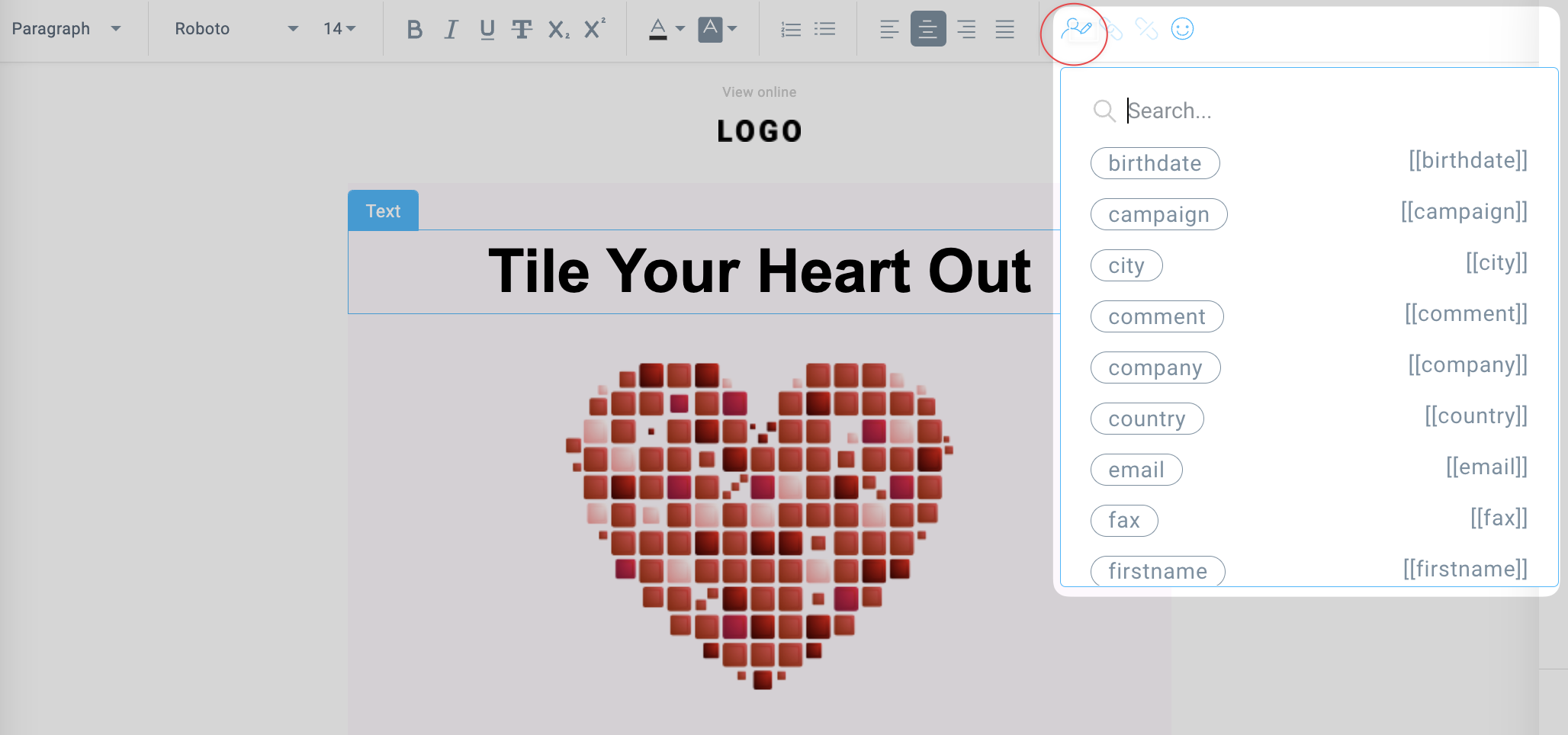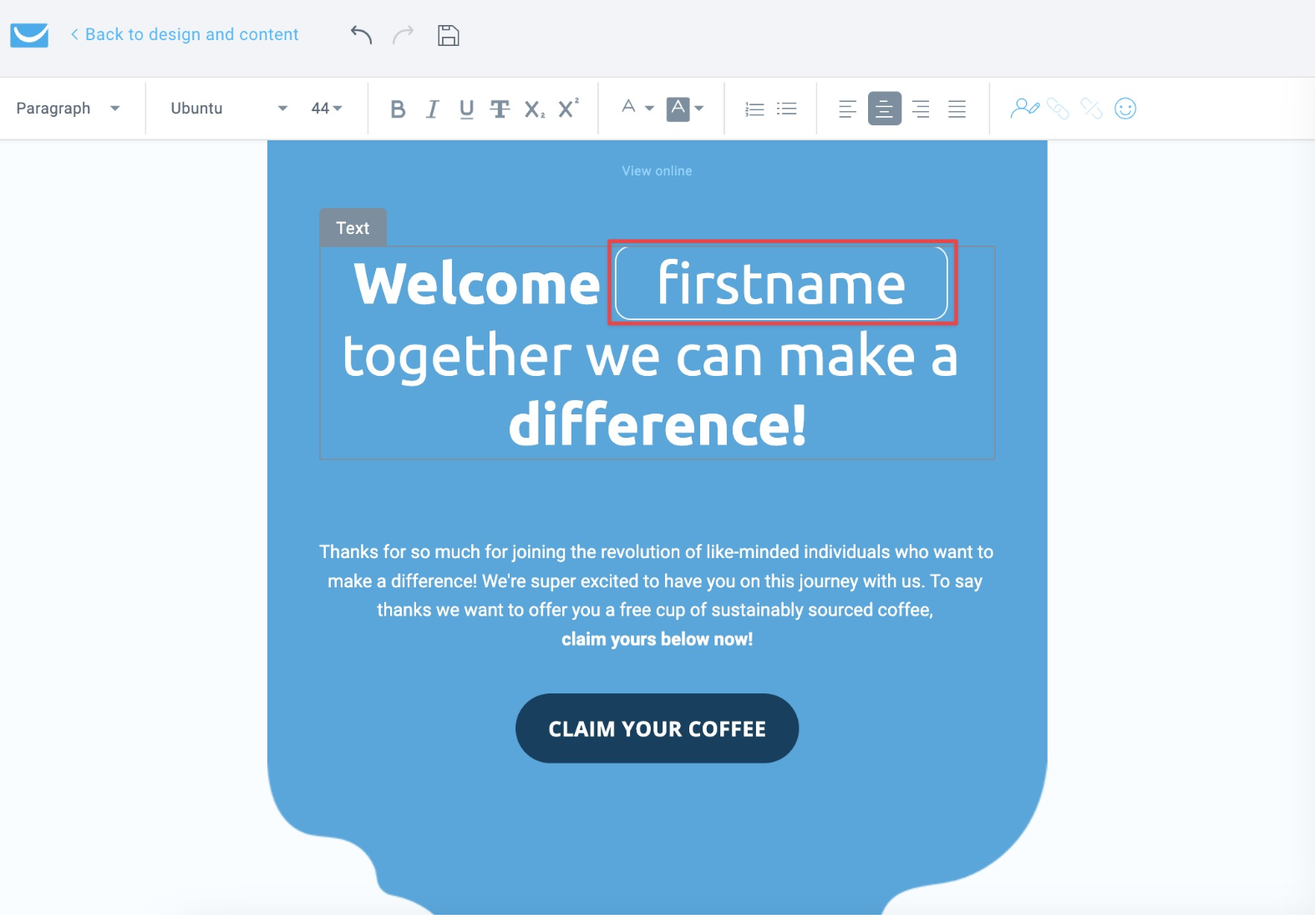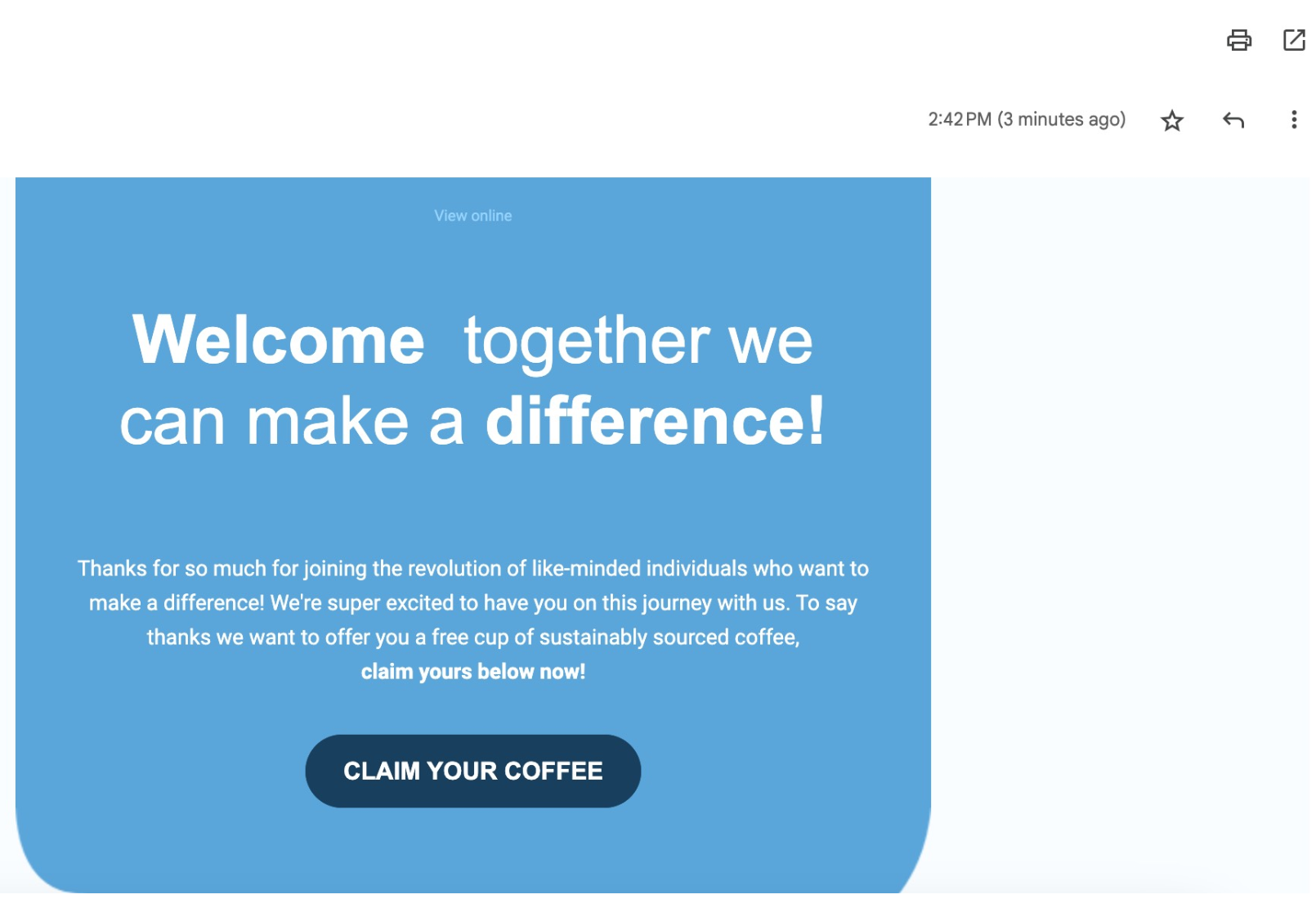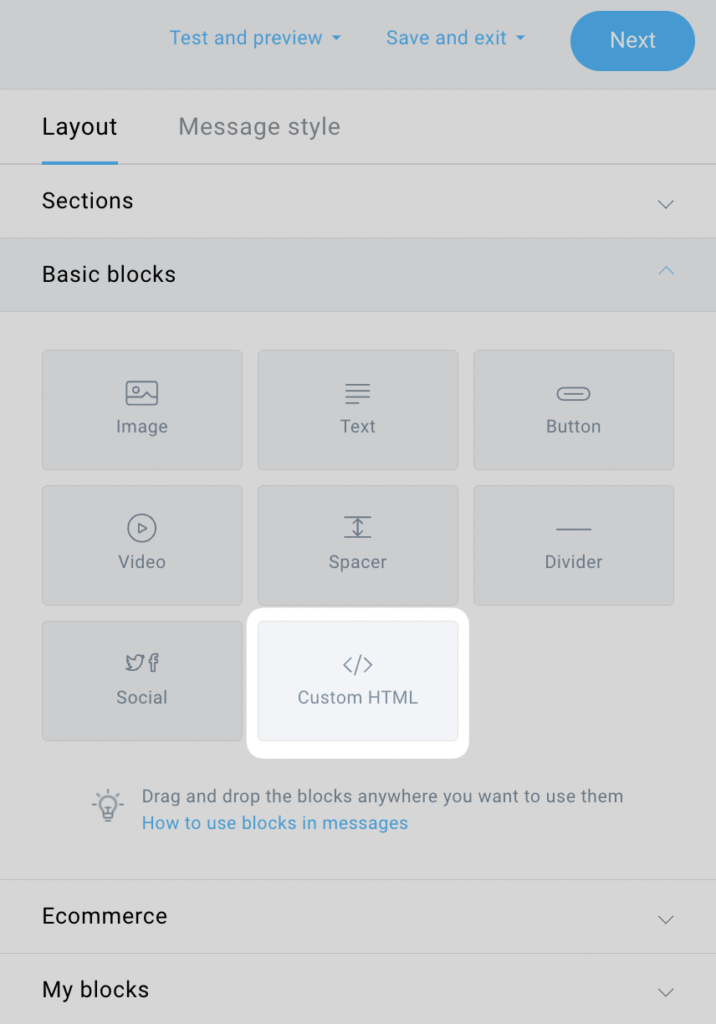How to personalize my emails? Video
It’s a great idea to personalize
Personalization will not work for test messages. To test it, add yourself to the contact list and send it as a newsletter. Alternatively, you can use the Preview feature to test it.
How to personalize messages?
In the new editor, you can use personalization by click on a text element and then clicking the personalization icon in the top editing bar.

Once you see the custom field

What happens if a custom field used in personalization is not assigned to
a contact?
If a given custom field is not assigned to your contact, we will display an empty value in a real message.
Example:
You used the firstname field in your message. One of your contacts didn’t provide their name while subscribing through your form. In such a case, will show an empty space in their mailbox:


How to add fallback to personalization?
You can define a default value for merge words that will be inserted when there is no data to display (the custom field value is empty), e.g.:
Your favorite color is {{CUSTOM `color` `your best kept secret`}}
which translates to:
Your favorite color is black (if the subscriber
or:
Your favorite color is your best kept secret (if the subscriber hasn’t picked their favorite color).
Another example involves the contact’s first name:
Hello {{CONTACT `subscriber_first_name` `Friend`}}
which translates to:
Hello John (if the subscriber has a name assigned),
or:
Hello Friend (if the subscriber has no name assigned).
Such dynamic content

Below you can find some examples.
To create a fallback greeting when name is not assigned, the following code can be used:
{{IF `(subscriber_first_name IS_DEFINED)`}}
Hi {{CONTACT `ucfw(subscriber_first_name)`}}!
{{ELSE}}
Hi dude!
{{ENDIF}}To create a fallback when there country is not assigned, the following code can be used:
{{CUSTOM `country` `Outerspace`}}How to create dynamic links?
You can create dynamic links based on a contact’s name or on a custom field that will be inserted to that link
To create any link you can either:
- select the text in your message and click the link icon

- click on the button and go to the side panel

Then select the link type from the dropdown. There are two ways of creating personalised links with our message editor.
Please find some examples of the link syntax and its possible outcome depending on on the selected link type:
- Web address
https://getresponse.com/{{CUSTOM `customfieldname`}}
https://getresponse.com/customfieldvalue
—https://getresponse.com/?first_name={{CONTACT `subscriber_first_name`}}&last_name={{CONTACT `subscriber_last_name`}}&email={{CONTACT `subscriber_email`}}&phone_number={{CUSTOM`phone`}}&schedule_id=2
https://getresponse.com/?Adam&Smith&adamsmith@example.com&+15555551234&schedule_id=2 - Custom protocol link
{{LINK `https://getresponse.com/{{CUSTOM `customfieldname`}}`}}
https://getresponse.com/customfieldvalue
Tutorial videos
Personalization in the legacy editor
The methods below apply only to the legacy message editor.
Subject line
To personalize the subject line, go to the Settings screen inside Email Creator, click the Personalize link and choose the option you need from the list.

To use them for personalization, either select it from the list or simply type the custom field’s name inside double square brackets, like this:
– [[favoritecolor]] – prints the value of the “favoritecolor” custom field.
– [[shoesize]] – inserts the value of the “shoesize” custom field.
Email creator
Click any text box inside the Email Creator and position the cursor where you want the personalization to appear. Then click the Personalize icon on the far right side of the text editing buttons and choose any field from the list.

Emoji
One of the most popular ways to make messages more human or to add a friendlier tone is emoji. 👍 It’s a good way to make your message stand out in your contacts’ inboxes (which helps increase your open rate). You can also use emoji to bring attention to specific words in your message, emphasize the content and introduce a little humor.
You can use an emoji in the message subject line and message body. To add emoji in your subject line:
1. Click the emoji icon in the subject line field.
2. Choose an emoji from the menu. Note: you can’t import your own emoji into the subject line.
To use emoji in the message body, copy it from the web and paste it where you need to using keyboard shortcuts.
Keep in mind that not all email service providers and browsers will display emoji the same way. It’s a good idea to send a test message to a number of the most popular inboxes to make sure that your contacts will be able to see the emoji the way you intended.
Note: using too many emoji can make your message look unprofessional. This increases the risk of your contact marking your message as spam. Always make sure that the emoji you’re using are appropriate to the tone and content of your subject line and message.
You can also use our A/B testing feature to check if using emoji is helping your messages perform better.
Merge words to personalize messages
Merge words are placeholders that you type in your message so our system can replace them with information about each of your contacts when the message reaches their inboxes. The information is pulled from fields such as name and address, and also from any other custom fields you assign to your contacts. In GetResponse, we typically use double square brackets: [[yourcustomfield]] though in some cases you will also need {{}}.
Here are the personalization merge words which you can use in messages:
– [[firstname]] – displays the contact’s first name (everything up to the first space in the name field)
– [[name]] – displays the contact’s first and last name
– [[lastname]] – displays the contact’s last name (everything after the first space in the name field)
– [[email]] – displays the contact’s email address
– [[responder]] – displays the list name
– [[ip_address]] – displays the contact’s IP address
– {{CONTACT "message_from_email"}} – displays your from field email address
– [[remove]] – displays the link to the unsubscribe page
– [[change]] – displays the link to the “Update your details” page
– [[view]] – displays the link to the online version of your message
Social Sharing
[[facebook]] [[X]] [[linkedin]] [[pinterest]] – these insert social sharing links that make it easy for your subscribers to share the email with their friends.
Geo-location
[[geo country]][[geo country code]][[geo region]][[geo postal]] and [[geo postal code]]insert geo-location data based on your subscriber’s IP address. Please note that this may not always be accurate. The data depends on the configuration of ISPs.
Capitalizing fields
To ensure that your custom fields are always grammatically correct, you can use our “beautifiers”. No matter what information goes into your custom fields, this option ensures that your email looks great, and not LiKE tHiS.
– [[firstname mode="ucfw"]]– “john” will become “John”
– [[name mode="ucfw"]] – “john smith” will become “John Smith”
– [[fav_activity mode="ucfs"]] – “I Love eMail Marketing!” will become “I love email marketing!”.
You can also change all the letters in a word to upper case or lower case using the following options:
– [[color mode="lc"]] – “YEllOW” will become “yellow”
– [[color mode="uc"]] – “yellow” will become “YELLOW”
Fallback when there’s no value to display
You can define a default value for merge words that will be inserted when there is no data to display (the custom field value is empty):
Your favorite color is [[color fallback="your best-kept secret"]].
… this will print:
Your favorite color is black. (if the subscriber has chosen black as their favorite color)
or if the subscriber hasn’t picked their favorite color:
Your favorite color is your best-kept secret.
Fallback and capitalizing
You are free to use both of these options at the same time. Here’s an example:[[name fallback="Friend" mode="uc"]]
Note The Fallback function does not capitalize all letters in the word Friend. This is the only exception.
Date and time
Use date and time to personalize your messages or inform your subscribers about upcoming or past events. The current date can be added using the merge word [[date format]], or [[date format="format"]]. Depending on the date format you want to achieve, replace the word format with one of the descriptions in bold:
– short to display MONTH/DAY/YEAR
– med to display MONTH_NAME DAY, YEAR
– long to display DAY_NAME, MONTH_NAME DAY, YEAR
– eu1 to display DAY/MONTH/YEAR eu2 to display YEAR-MONTH-DAY
– day to display DAY_NAME
– month to display MONTH_NAME
– time to display HOUR:MINUTE
– hour to display HOUR
Example[[date short]] and [[date format="short"]] will insert today’s date as 02/22/2013.
You can use date shifting to provide dynamic dates for when a particular event will happen. Use it in your messages to, for example, let your subscribers know when you’ll send out the next email.
Example
Today is [[date day]]. The new autoresponder message will be sent to you on [[date format="day" shift="+3 days"]] will insert:
“Today is Monday. The new autoresponder message will be sent to you on Thursday.”
Depending on the outcome you want to achieve, use “+” for future events and “-” for past events. You can also use the personalization to count down the time to or from important moments. You can make it count down in:
- years (ye)
- months (mo)
- days (da)
- hours (ho)
- minutes (mi)
- seconds (se).
The values in brackets represent the format you can use to display the correct unit of time.
Finally, you can personalize your messages with your subscriber’s sign up date:{{ADDED_ON "you subscribed on DAY_ORDINATED of MONTH_NAME, it was DAY_NAME"}} will insert:
“You subscribed on 11th of July, it was Friday.”
Example
Today is [[date short]]. The New Year’s Eve is in [[timer datetime="2014-01-01"format="da"]] days! will insert:
“Today is 02/22/2013. The New Year’s Eve is in 311 days!”
Our last meeting was [[timer datetime="2013-01-01" format="da"]] days ago will insert:
“Our last meeting was 53 days ago.”
The same rules can be applied to your RSS-to-email messages. There are also a few more personalization merge words which you can add to RSS email.
This blog post covers nine simple ways to personalize your email marketing campaigns, increase subscriber engagement, and improve conversion rates.




